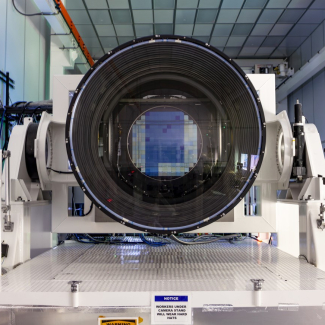
Mars: first results from the Perseverance rover
|
|
The Perseverance rover has now confirmed the suitability of its landing site: Jezero crater really did contain a lake, into which a river flowed through a delta 3.6 billion years ago. Led by a CNRS researcher, the international team involved scientists in France from Université Claude Bernard Lyon 1 and Université Toulouse III - Paul Sabatier1 , and published its findings on October 7 in Science. The observations were obtained using the NASA rover's SuperCam instrument, built in France under the supervision of the French space agency CNES.
Perseverance landed on the surface of Mars last February and immediately began to explore its surroundings, with the goal of better understanding the past history of the Red Planet. In this very first study based on data from the rover, led by a CNRS geologist from the Laboratory of Planetology and Geodynamics (CNRS / Université de Nantes/Université d’Angers), the NASA rover has confirmed the relevance of its landing site and shed new light on its hydrological evolution.
Jezero crater was chosen because satellite images provided geological evidence that suggested the presence of an ancient lake at the mouth of a river valley. Perseverance observed a series of inclined sedimentary strata there, sandwiched between horizontal strata. This is a typical pattern found in deltas on Earth and one that can be used to determine the level of the lake at the time of deposition. The findings confirm that Jezero crater was once filled by a lake, and also provide fresh information about it: 3.6 billion years ago, this body of water was several tens of metres deep and covered the entire floor of the crater, an area about 35 km in diameter.
The research team also identified totally different strata above the lacustrine deposits, characterised by the presence of large cobbles and boulders more than one metre across. These deposits provide evidence of high river flow rates, typical of flash floods. The end of the crater's lacustrine period was therefore connected to a radical transformation of the hydrological regime, probably indicating a major change in the climate.
The rover carried out its observations more than 2 km away from the geological formations being studied, thanks to the American Mastcam-Z instrument and especially to the French-American SuperCam, whose camera can at this distance observe details of less than 10 cm.
These results will inform the rover's future research programme inside Jezero crater, since the two types of rocks identified are major targets for the mission: sedimentary strata are excellent candidates for finding traces of past life, while large boulders may provide fragments of Martian crust. Samples could be collected with a view to returning them to Earth by 20302 .
Visual resources are available on request by writing to francois.maginiot@cnrs.fr
To find out more about the SuperCam instrument and the March 2020 mission: https://supercam.cnes.fr/fr

Left: © NASA / JPL-Caltech / MSSS / LPG / Science Right: © NASA / JPL-Caltech / LANL / CNES / CNRS / IRAP / LPG / Science
Perseverance rover reveals ancient delta-lake system and flood deposits at Jezero crater, Mars. N. Mangold, S. Gupta, O. Gasnault, G. Dromart, J. D. Tarnas, S. F. Sholes, B. Horgan, C. Quantin-Nataf, A. J. Brown, S. Le Mouélic, R. A. Yingst, J. F. Bell, O. Beyssac, T. Bosak, F. Calef III, B. L. Ehlmann, K. A. Farley, J. P. Grotzinger, K. Hickman-Lewis, S. Holm-Alwmark, L. C. Kah, J. Martinez-Frias, S. M. McLennan, S. Maurice, J. I. Nuñez, A. M. Ollila, P. Pilleri, J. W. Rice Jr, M. Rice, J. I. Simon, D. L. Shuster, K. M. Stack, V. Z. Sun, A. H. Treiman, B. P. Weiss, R. C. Wiens, A. J. Williams, N. R. Williams and K. H. Williford. Science, 7 October 2021. DOI:10.1126/science.abl4051
Contact
Notes
- In France, researchers from the following institutions were involved in this work: Laboratoire de Planétologie et Géodynamique (CNRS/Université de Nantes/Université d’Angers), Institut de Recherche en Astrophysique et Planétologie (CNRS/CNES/UT3 Paul Sabatier), Laboratoire de Géologie de Lyon--Terre, Planète, Environnement (CNRS/ENS de Lyon/Université Claude Bernard Lyon 1) and Institut de Minéralogie, de Physique des Matériaux et de Cosmochimie (CNRS/MNHN/Sorbonne Université).
- As part of the joint NASA / European Space Agency Mars Sample Return mission.


